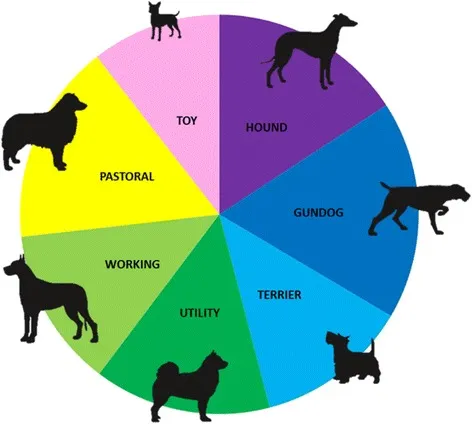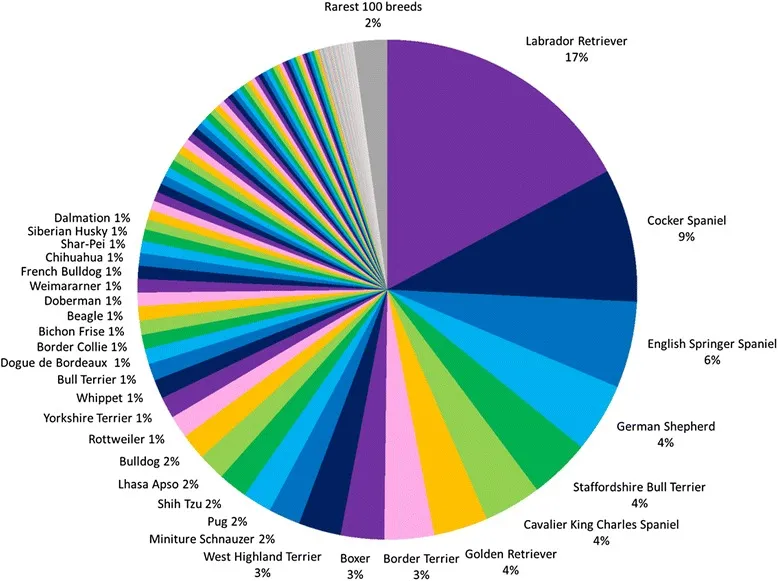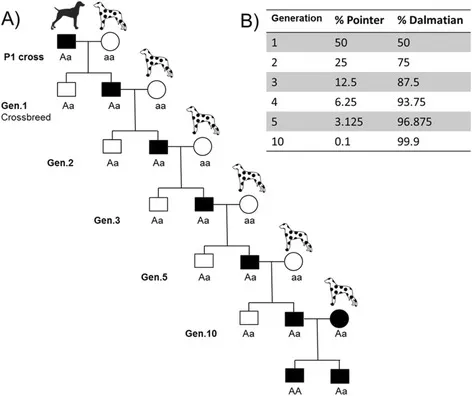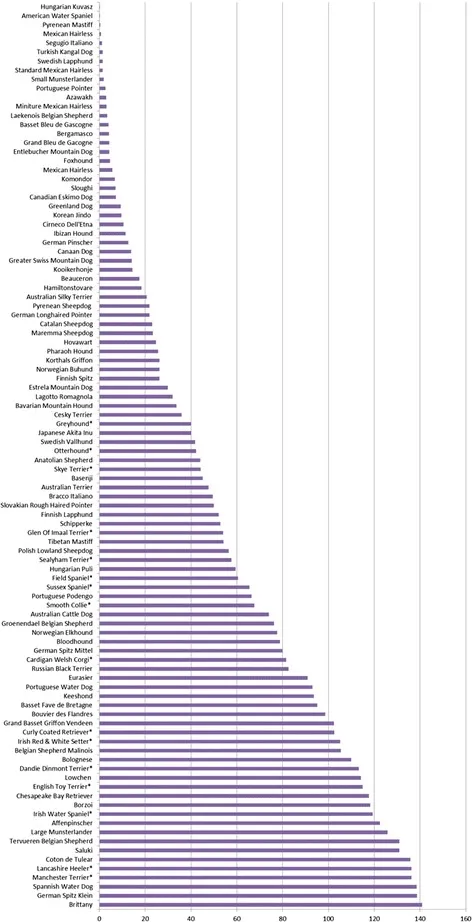For thousands of years, dogs have been our steadfast companions, evolving alongside humanity from working animals to cherished family members. The journey of dog domestication has led to the incredible diversity of breeds we see today, each with unique appearances and temperaments. However, this intentional selection for specific traits, particularly in the last few centuries, has also inadvertently brought about a significant challenge: the prevalence of Genetic Diseases In Pedigree Dogs. As experts in dog care and welfare, we at Dog Care Story believe it’s crucial for every dog owner and enthusiast to understand these inherited conditions, their origins, and the strategies being developed to combat them.
The development of distinct pedigree dog breeds, often through inbreeding within closed familial lines, has been a double-edged sword. While it has successfully rigidified desirable features, it has also, at times, inadvertently fixed undesirable, disease-causing genes within the breed’s genetic blueprint. These diseases can sometimes only manifest when a dog inherits two copies of a faulty gene (recessive inheritance). The widespread use of a “Champion Sire” carrying such a gene can rapidly disseminate the mutation across an entire breed population. Similarly, if a breed originates from a small group of founder dogs, and one or more of these founders carry disease genes, the frequency of these diseases is likely to increase as the population grows. Sadly, even extreme forms of breed characteristics, initially selected for their aesthetics, can sometimes contribute directly to health and welfare issues. This comprehensive guide will objectively delve into the background of inherited genetic diseases in pedigree dogs, exploring how breeding strategies and genetic testing can help reduce disease frequency while maintaining crucial genetic diversity within each breed.
The Evolution of Dog Breeds and Genetic Challenges
The formalization of dog breeds, as we know them, primarily began in the 19th century with the rise of dog showing and structured breeding during the Victorian era. Organizations like the Kennel Club in the UK and USA were founded to govern these practices, establish breed standards, and register dogs. Today, the UK Kennel Club alone recognizes 215 breeds, categorizing them into seven groups based on their original functions: Hound, Gundog, Terrier, Utility, Working, Pastoral, and Toy. In 2013, over 216,000 purebred dogs were registered, demonstrating the enduring popularity of these distinct breeds.
However, the very system designed to preserve breed purity also created “breed barriers,” leading to reproductive isolation. Each breed effectively became a closed breeding population, resulting in high levels of phenotypic homogeneity – meaning dogs within a breed look very similar – but also significant genetic differences between breeds. This isolation has led to several critical genetic issues:
- Genetic Bottlenecks: Two major bottlenecks have reduced genetic diversity in purebred dogs. The first occurred during domestication, and the second, more recently, during breed formation. The repeated use of popular sires, line breeding, and selection for specific traits within closed populations have collectively diminished genetic variation.
- The Popular Sire Effect: When a male dog with desirable traits is used extensively for breeding, his genome becomes overrepresented in the breed. This significantly reduces overall genetic diversity and, crucially, can rapidly spread monogenetic inherited disorders if that sire carries recessive deleterious variants.
- Inbreeding: Many breeds have undergone significant inbreeding to maintain specific breed standards. While sometimes necessary to fix desired traits, high levels of inbreeding increase homozygosity for detrimental alleles, directly contributing to the number of inherited disorders in specific breeds. For instance, the Bouvier des Flandres breed exhibits high homozygosity, and many inherited disorders are believed to have increased in prevalence as a result.
 Grouping of purebred dog breeds
Grouping of purebred dog breeds
Figure 1: This pie chart illustrates the distribution of 215 purebred dog breeds recognized by the UK Kennel Club across its seven functional groups. The varying sector sizes represent the number of breeds within each category, from hunting Hounds and Gundogs to companion Toy breeds, highlighting the extensive diversity in breed function and form.
While some studies suggest that current levels of inbreeding don’t always directly correlate with increased disease incidence, possibly due to vigilant screening by breeders or historical genetic purging, the overall loss of genetic variation is undeniably linked to unhealthy morphologies and physiologies in many breeds. This emphasizes the urgent need for thoughtful breeding strategies that improve breed health while carefully preserving their unique characteristics.
The concentration of registrations also shows a trend towards popular breeds. The top 20 most popular breeds account for 72% of total registrations, while the rarest 100 breeds, including 16 native UK vulnerable breeds, make up only 2%. This disparity further concentrates genetic material within a few popular lines, exacerbating the issues of reduced genetic diversity.
 Proportion of purebred UK Kennel Club registered dogs (2003-2013)
Proportion of purebred UK Kennel Club registered dogs (2003-2013)
Figure 2: This chart shows the distribution of UK Kennel Club registered purebred dogs between 2003 and 2013. It highlights that a small number of popular breeds dominate registrations (72% from the top 20), while a large number of rarer breeds (100 breeds accounting for 2%), including vulnerable native UK breeds, face significantly lower registration numbers, indicating uneven genetic representation.
The Impact of Artificial Selection on Canine Health
The shift in focus from working abilities to aesthetic features in dog breeding has had profound consequences. Over 75% of inherited disorders in pedigree dogs are unrelated to breed standards, largely attributed to breed formation and reduced genetic diversity. However, more than 80 disorders are either directly or indirectly associated with the requirements of published breed standards, significantly impacting a dog’s health and welfare. Artificial selection, by prioritizing specific phenotypes, effectively bypasses natural selection. Comparing historical photographs of breed champions with their modern counterparts reveals a clear trend towards exaggerated phenotypes in some breeds.
Exaggerated Morphologies and Associated Health Issues
Perhaps the most striking examples of extreme breed morphology are found in breeds with altered skull shapes and sizes. The modern English Bulldog, for instance, bears little resemblance to its athletic ancestors. Its large, flat-faced (brachycephalic) head, bowed limbs, and broad chest are now characteristic. This extreme conformation means that up to 94% of English Bulldog births require Caesarean sections because the foetus’s head is too large to pass through the female’s pelvis naturally.
This human intervention, while enabling the continuation of certain aesthetic features, comes at a cost. Brachycephalic airway syndrome (BAS) is a common respiratory condition in flat-faced breeds like Pugs, Bulldogs, and Boston Terriers. It results from multifocal respiratory resistance due to pinched nostrils, occluded turbinates, and an elongated soft palate. In severe cases, this leads to exercise intolerance, overheating, and increased mortality. These breeds are also prone to ocular morbidities, such as eye trauma and proptosis, due to their shallow eye sockets. When such puppies are delivered by C-section, there’s no natural selection against these detrimental traits, thus allowing associated morbidities and mortalities to persist and even increase.
Beyond skull shape, trends pushing the limits of body size also contribute to health issues. Toy breeds, often selected for their petite size, can suffer from bone fragility and abnormal bone growth. “Teacup” varieties, weighing just a few kilograms, frequently have unclosed fontanelles (soft spots) on their heads, a condition related to underdeveloped cranial bone. Conversely, giant breeds are susceptible to growth-related problems, including the crippling orthopedic condition osteochondrosis, osteosarcoma (bone cancer), and gastric dilation volvulus. It’s widely recognized that giant breed dogs generally have shorter lifespans, a phenomenon linked to their rapid growth rate and the complex morbidities associated with it.
The relationship between dog morphology and disease is undeniable. As we uncover more genetic variants underlying these morphologies, it becomes crucial to determine if these variants have pleiotropic effects, predisposing dogs to a range of diseases beyond just their physical appearance. Understanding the underlying hip dysplasia in dogs genetics and other common skeletal issues is key to improving overall breed health.
Management of Inherited Diseases: Strategies and Challenges
The increasing awareness of inherited disorders has led to significant efforts in management and prevention. Organizations like the British Small Animal Veterinary Association and the UK Kennel Club have been instrumental in identifying conditions of concern and implementing programs to improve breed health. It’s vital to remember that a breed’s susceptibility to certain disorders doesn’t mean every individual will develop them; the likelihood depends on various factors, including the practices of individual breeders.
Breeding Strategies and Screening Schemes
The UK Kennel Club’s Assured Breeders Scheme promotes good breeding practices, requiring breeders to adhere to mandatory screening for potential sires and dams. This includes breed-specific DNA tests and schemes for conditions like eye diseases, elbow dysplasia, and hip dysplasia in dogs genetics. These screening protocols aim to prevent carriers from passing on known hereditary diseases.
Breeding strategies incorporating such screening schemes have proven highly successful in reducing the prevalence of inherited disorders. For example, patellar luxation, a common orthopedic disorder, was significantly reduced in the Dutch Kooikerhondje breed through a screening scheme based on orthopedic examinations. From 1994 to 2009, its prevalence decreased from 28% to 19%. Combining these schemes with pedigree and genotyping information can further reduce complex inherited disorders. Recent genome-wide association studies are identifying specific genetic markers (SNPs) linked to conditions like patellar luxation, offering new opportunities for targeted screening.
However, not all screening schemes have yielded similar success. The Cavalier King Charles Spaniel (CKCS) is prone to 25 inherited disorders, with early-onset myxomatous mitral valve disease (MMVD) being the most common, accounting for a significant percentage of deaths. Despite voluntary MVD breeding protocols, a Swedish study found no significant reduction in heart murmur prevalence in CKCS dogs within the first two years of implementation. This highlights the complex genetic nature of some diseases and the need for long-term, potentially multi-generational strategies.
Estimated Breeding Values (EBVs) and Genomic Selection
Estimated Breeding Values (EBVs) are increasingly being used as a tool to screen potential sires and dams for genetic diseases, especially those with complex inheritance patterns. An EBV measures an animal’s genetic potential to pass a specific trait to its offspring, calculated using its phenotype, relatives’ phenotypes, and pedigree relationships. These have been widely successful in livestock breeding for decades.
For dogs, EBVs are being introduced for traits like hip and elbow dysplasia. The next frontier is genomic selection, where Genomic EBVs (gEBVs) are calculated using genome-wide genetic markers instead of just pedigree information. This approach is expected to substantially increase the rate of response for complex traits. A comprehensive strategy, combining new and existing screening schemes, pedigree information, and EBVs or gEBVs, is crucial for managing and reducing inherited disorders while preserving genetic diversity, especially in rare breeds or those with small populations.
Limitations of DNA Disease Tests
While invaluable, DNA tests have limitations. Not all available health tests are mandatory, and making too many mandatory could deter breeders from participating in voluntary schemes. Furthermore, breeding decisions should never rely solely on genetic testing. Eliminating an individual from the breeding population based on a single allele could inadvertently reduce effective population size, increase inbreeding, or unintentionally propagate other deleterious alleles in linkage disequilibrium. Many tests are based on preliminary relationships, making a full understanding of the genetic basis of a condition essential before implementing widespread testing.
An example of complex inheritance: Goniodysgenesis, a developmental abnormality of the eye, is strongly linked to primary closed angle glaucoma (PCAG) in Border Collies, a significant cause of irreversible blindness. While some lineages have a high incidence, not all affected dogs develop glaucoma. The underlying genetic architecture is complex, potentially involving multiple genes (genetically heterogeneous) or gene interactions (epistatic). Until this relationship is fully understood, breeding strategies based solely on goniodysgenesis or a single DNA test may not effectively eliminate glaucoma.
Genetic Heterogeneity: Progressive Retinal Atrophy (PRA) exemplifies the challenge of genetic heterogeneity. Documented in over 100 breeds, PRA involves various forms of retinal degeneration, with differing etiologies and ages of onset. Multiple distinct mutations can be present in a single breed, or even within an individual dog, making breed-specific PRA DNA tests potentially misleading. To accurately assess PRA risk, all available diagnostic and genetic tests, alongside pedigree information and potentially genome-wide genotyping, are necessary for informed breeding decisions. Issues such as a german shepherd enzyme deficiency or other breed-specific metabolic disorders further highlight the need for tailored and comprehensive genetic screening.
Introgressing the Normal Allele
In cases where a breed population carries a high frequency of a known detrimental allele, a strategy called “introgression of the normal allele” can be employed. This involves crossbreeding with an animal free of the detrimental allele, then repeatedly backcrossing to the original lineage while monitoring for the desired healthy allele.
A notable example is the Dalmatian, all purebred individuals of which are homozygous for a mutation in the SLC2A9 gene, leading to hyperuricosuria and a risk of painful urinary calculi. This mutation is thought to be linked to the distinctive spotted coat pattern. To address this, a Dalmatian was outcrossed with a Pointer (homozygous for a functional SLC2A9 allele), and successive backcrosses were performed. After five generations, the progeny were 96.9% Dalmatian genetically, with the healthy allele. By ten generations, this increased to 99.9%.
 Replacing a detrimental allele
Replacing a detrimental allele
Figure 3: This diagram illustrates the strategy of replacing a detrimental allele through crossbreeding. (A) A purebred dog from a breed with a healthy, functional allele is crossed with an individual from a breed homozygous for an inactivating mutation (P1 cross). Progeny carrying the normal allele are then selected and repeatedly backcrossed to purebred animals from the breed of interest. (B) After multiple generations of backcrossing, the genetic contribution from the desired breed increases significantly, allowing for the eventual production of homozygous healthy offspring with minimal genetic change to the original breed, demonstrating how genetic diversity can be managed while reducing inherited diseases.
Despite its success in improving health outcomes, such initiatives can face resistance from breed clubs concerned about maintaining breed purity. This underscores the importance of public and breeder support for changes that ultimately benefit the breed’s health.
The Future of Pedigree Dogs
The challenges posed by genetic diseases in pedigree dogs have far-reaching implications. High premiums for insuring certain breeds, especially those predisposed to poor health, reflect the financial burden on owners. Some veterinarians even advise clients against purchasing certain pedigree breeds due to known inherited disorders.
For the long-term well-being of dogs, several solutions are being debated:
- Loosening Genetic Barriers: Some suggest abandoning the most predisposed breeds and loosening genetic barriers between the remaining ones to promote genetic variability. While this could ensure the survival of dog breeds in general, it might mean sacrificing the strict characteristics of specific breeds.
- Controlled Crossbreeding: A more realistic approach for predisposed breeds involves strategic crossbreeding with several individuals from a closely-related, healthy breed to reintroduce genetic variation. This strategy, combined with breeding schemes to select away from susceptible individuals, can create more genetically diverse future generations while largely maintaining breed standards, as demonstrated by the Dalmatian x Pointer cross.
- Limiting Offspring per Stud: Kennel Clubs worldwide could impose limits on the number of offspring per stud dog, reducing the “popular sire effect” and promoting increased genetic variability across the population. Such restrictions are already in place for some breeds, like the German Shepherd Dog.
- Monitoring Inbreeding: For rare breeds or those with decreasing population sizes, efforts should focus on mating unrelated sires and dams, using kinship coefficients from pedigree information and incorporating genotyping data to monitor inbreeding at an individual level. Projects like Dogslife™ in the UK, which tracks individual dogs’ health and life history, offer models for managing such breeds.
“Designer Dogs” and the Need for Responsible Breeding
A growing trend of “designer dogs,” first-generation crossbreeds like Labradoodles (Labrador Retriever + Standard Poodle) or Puggles (Pug + Beagle), has emerged. While often perceived as healthier due to hybrid vigor, this is a misconception if not carefully managed. Outcrossing can increase heterozygosity and reduce the frequency of disease-causing alleles. However, breeders must carefully select parent animals to maximize genetic variability and avoid lineages known for genetic diseases common to both parent breeds (e.g., hip and joint diseases in Labradors and Poodles).
The hybrid vigor typically diminishes beyond the first (F1) cross. Subsequent breeding to fix “designer dog” phenotypes requires vigilant monitoring to maintain genetic diversity and exclude known inherited conditions. Simply breeding for appearance without genetic considerations can lead to new inbreeding issues and genetic bottlenecks, undermining the very health benefits sought by outcrossing.
It’s also worth noting that many established native breeds in the UK face dangerously low population levels, with many registering fewer than 20 dogs per year. Instead of focusing solely on creating new “designer” breeds for arbitrary aesthetics, there’s a strong argument for dedicating efforts to preserving these vulnerable native breeds and aggressively tackling the inherited disorders already present in purebred dogs.
 Rarest 100 dog breeds in the UK
Rarest 100 dog breeds in the UK
Figure 4: This bar chart displays the average annual registrations for the 100 rarest dog breeds in the UK from 2004-2013. It reveals that over 30 of these breeds register fewer than 20 dogs per year, with 16 native UK breeds marked as vulnerable (asterisked) registering between 40 and 136 dogs annually. This highlights the critical conservation status of many established breeds and the severe implications of their declining numbers on genetic diversity.
Conclusion
The fight against genetic diseases in pedigree dogs is a complex but crucial endeavor for the welfare of our beloved companions. While significant challenges remain, a multi-faceted approach offers the most promising path forward. Incentive programs, accessible diagnostic screening, and genetic testing are vital tools, but public awareness and breeder participation are paramount.
DNA tests that directly identify disease-causing mutations are the most informative and effective for disease management. However, their impact is maximized when combined with current screening schemes, comprehensive pedigree information, and, where possible, advanced genomic selection techniques. Embracing controlled crossbreeding to introduce healthy genetic variations, accepting the registration of dogs with distant outcross ancestors, and imposing offspring limits on stud dogs globally can significantly improve breed health without compromising essential breed standards.
Ultimately, public awareness, education, and, most importantly, the unwavering support of breeders, breed clubs, and dog owners are the driving forces behind making these vital changes successful and common practice. By working together, we can ensure a healthier, more vibrant future for all pedigree dogs.
References
- BMC Veterinary Research. (2015). Inherent problems in pedigree dog breeding.
- The Kennel Club (UK). Official breed standards, health schemes, and breeder information.
- British Veterinary Association (BVA). Canine Health Schemes.
- Universities Federation for Animal Welfare (UFAW). Information on animal welfare.
- American Kennel Club (AKC). Official breed standards and health information.
- PDSA (People’s Dispensary for Sick Animals). Pet care and eligibility guidelines.
